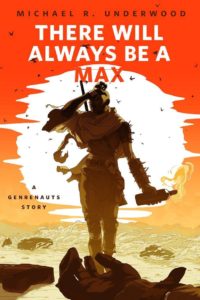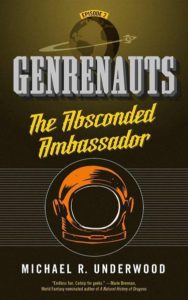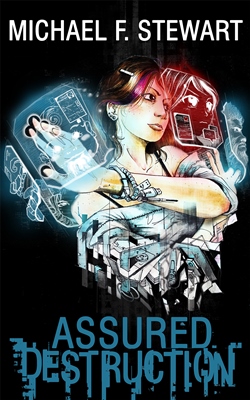(This is part “Three Questions With Xxxx“. If you’re interested in taking part click here and fill out the form.)
 I became aware of Michael and his talent through podcasting and mutual friends. When I saw the concept behind his series Genrenauts and learned about the Kickstarter he’s running to fund it, I immediately wanted to ask him some questions.
I became aware of Michael and his talent through podcasting and mutual friends. When I saw the concept behind his series Genrenauts and learned about the Kickstarter he’s running to fund it, I immediately wanted to ask him some questions.
1) I love shorter fiction. Doorstops turn me off, so short stories and novellas are my cup of tea. I’m starting to see more and more shorter works published, perhaps at least in part because of the ease of publication these days. What is it about this length/format that appeals to you as a writer (and perhaps as a reader)?
MU: Like many writers, I started with short fiction before I tried my hand at writing a novel. Once I got into long form, I mostly stayed there, since most of what I read growing up and most of what I read now is longer-form. I got into novellas through my first series, the Ree Reyes urban fantasies, when my publisher asked me to write a novella to tide the series over while I tried out another idea. It was really fun for me to investigate that middle format, with some of the density and focus I associate with short fiction while still having the space to develop a longer plot, to include action sequences, and other aspects that I hadn’t really been able to do in short fiction.
 As a reader, I’ve become more and more fond of novellas as I’ve been reading other works from my fellow Tor.com Publishing authors – it’s really fun to see how much variation there is even within the constraints of the novella format – a one-POV novella of just between 18K and 20K words (like Binti by Nnedi Okorafor or Domnall and the Borrowed Child by Sylvia Sprunk Wrigley) is a very different beast from an almost-40,000-ish word work that’s as much short novel as long novella (like The Sorcerer of the Wildeeps by Kai Ashante Wilson). The novella is an incredibly flexible format, and every one I read, I come to appreciate it more, and agree even more with scholars and legends who hold it up as the perfect length for speculative fiction.
As a reader, I’ve become more and more fond of novellas as I’ve been reading other works from my fellow Tor.com Publishing authors – it’s really fun to see how much variation there is even within the constraints of the novella format – a one-POV novella of just between 18K and 20K words (like Binti by Nnedi Okorafor or Domnall and the Borrowed Child by Sylvia Sprunk Wrigley) is a very different beast from an almost-40,000-ish word work that’s as much short novel as long novella (like The Sorcerer of the Wildeeps by Kai Ashante Wilson). The novella is an incredibly flexible format, and every one I read, I come to appreciate it more, and agree even more with scholars and legends who hold it up as the perfect length for speculative fiction.
In addition to appreciating that variation, I love novellas as a palate cleanser. I can read a 120,000 word serious, deliberate book, then breeze through a 25,000-word adventure to clear my head, to round out my emotional landscape. Or I can set up a stack of three novellas and read them all over a long weekend without that being all I do over those three days.
In a world where there are an infinite number of shiny things vying for our attention, novellas are even more appealing as a form of written storytelling – they’re the Goldilocks planet of fiction – not too long, not too short – they’re just right.
2) Serial fiction is nothing new. This approach to writing and releasing prose is likely as old as writing itself. Then, as you pointed out on your Kickstarter page, is also thanks in part to television. What challenges do you face in putting out serial fiction and how have you overcome them in this series?
 MU: The Kickstarter is in no small part a direct response to the challenges of serial fiction – I had a serial work that I wasn’t able to publish fast enough to operate the way I felt it needed to. Tor.com invested a lot of resources and gave me support, but they weren’t in a position to publish all six novellas of season one in rapid succession. The Kickstarter, if successful, will give me the means to publish episodes 3 through six in rapid succession.
MU: The Kickstarter is in no small part a direct response to the challenges of serial fiction – I had a serial work that I wasn’t able to publish fast enough to operate the way I felt it needed to. Tor.com invested a lot of resources and gave me support, but they weren’t in a position to publish all six novellas of season one in rapid succession. The Kickstarter, if successful, will give me the means to publish episodes 3 through six in rapid succession.
Another challenge for serial fiction, I think, is binge watching culture. Thanks to Netflix and to some notoriously unfinished prose series, a lot of people prefer to consume an entire series all at once, or at least a large portion of narrative all at once. Reading 150 pages per chunk is outside the normal reading habit for a lot of people, so working in a serial fiction space carries some effort to reorient readers into this older form of reading (though it is the dominant way a lot of the first, truly broadly English-language commercial fiction was consumed). I’ve tried to plan for that inclination to want to read in big chunks by balancing my stories between the serial and episodic modes. The episodes all feed in together to larger stories, but each episode has its own internal arcs, largely framed by the ‘case of the week’ structure of the Genrenauts’ field missions.
 3) This series was originally being published by Tor. Due in part to a desire to release these with greater frequency, you’re publishing the next several “episodes” independently. As you’ve said, Tor was okay with that. Did that reaction surprise you and what challenges do you think you’ll face as a result of this change?
3) This series was originally being published by Tor. Due in part to a desire to release these with greater frequency, you’re publishing the next several “episodes” independently. As you’ve said, Tor was okay with that. Did that reaction surprise you and what challenges do you think you’ll face as a result of this change?
The possibility of continuing the series on my own was a part of the conversation with Tor.com from the beginning. Being a publishing professional in my day job, and having worked with my editor previously as a colleague, it was easier for my agent and I to talk very frankly about the different possibilities of what might happen down the road with the series. The permission to republish the Tor.com episodes in a collected edition was in the contract from the very beginning, which has made this transition much easier (it wasn’t a surprise, it was option #2 on a list of several options, all of which were discussed before I signed the contract for Episodes 1 & 2.)
There are, however, still challenges. From what I’ve learned about indie/author-publishing, not having direct control of every story in a series makes some strategies and tactics that have worked well for other authors more difficult for me – I have to work with the Tor.com model and make what they’re doing into strengths for the series. The Tor.com business model is digital-leaning, which lines up well with the also digital-leaning indie publishing. The first two episodes got much more of a buy-in to libraries thanks to Macmillan’s strength in that field, so I know that I can and should be on the lookout for ways to support and reach out to libraries. Since I work in publishing, I feel fairly confident that I’ll be able to build my indie-published episodes and collections on top of the platform for the series that Tor.com and I built together with the first episodes, especially as they continue to support them and the series writ large.
BONUS QUESTION – Since this is an effort to crowdsource the rest of the series, I wanted to know if this is successful (and I hope it is), whether you intend to do more independent publishing as a result and what you think about the future of “hybrid” authors (those that have been published both traditionally and independently).
MU: I definitely plan to continue publishing some of my work independently. I have tried to approach my writing career using a hybrid author mentality for most of two years now, though this is my first independent publishing project (I self-pubbed a short story to my mailing list a while back, but that was a very small, ‘thanks for being awesome gift’ kind of affair). I wholeheartedly agree with the hybrid publishing pioneers who have called for authors to broaden our perspective, to take control of our publishing careers and destinies, in order to better weather the tides of publishing.
For me, more hybrid authors means more authors thinking about the business side of their careers. Which then means means more authors confident to push back on bad clauses in publishing contracts, more authors who know there are other options if a deal falls through. It means more careers that survive a dip due to one poorly-selling book or shift in the market. It means more independently-published authors making smart choices on when and why they might want to sign a traditional contract in order to gain the reach and support that traditional houses can offer. Add in crowdfunding tools like Patreon and Kickstarter and there are really enough option to build a publishing career in a very deliberate, efficient way, and I hope that we see it continue to pay off for a lot of writers. There are always going to be writers that aren’t interested in the entrepreneurial mindset that helps make selling indie more viable, but those who have the flexibility and patience to use each path for its advantages to weave together a diverse publishing portfolio will, I think, find a lot of opportunities and more chances to make a sustainable career.


 Zen sent me an email a few days ago to let me know about his new Kickstarter which can be found here –
Zen sent me an email a few days ago to let me know about his new Kickstarter which can be found here – 